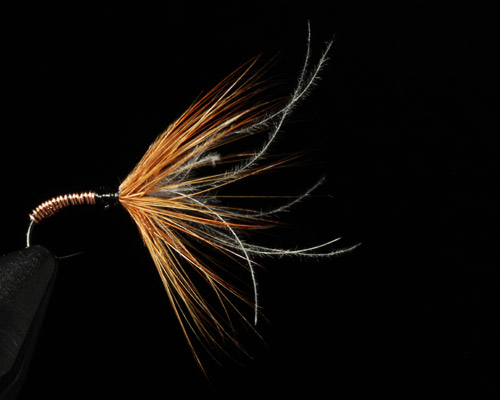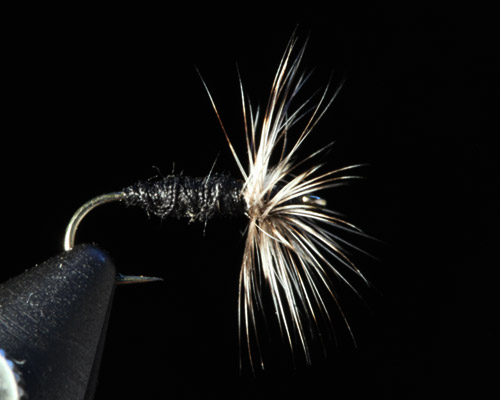Archive for the ‘Fishing technique’ Category
Tenkara techniques: Part 3 (sinking your fly)
Think about the origins of tenkara and western fly-fishing. Tenkara was originated by commercial fishermen, whose livelihoods depended on very efficiently and cheaply catching fish. Instead of spending time tying different flies on to the end of their line, or time and money making different patterns or making sinking devices, they relied on technique, learning how to present and manipulate their one fly. Most tenkara anglers will stick with one pattern only, and make it work with whatever situation they are presented with, even if it means they need to sink a fly without split shot or heavily weighted flies.
Many people believe they need to use a nymph, a heavy hook, or – UGH! – split shot to sink a fly. Casting a line with split shot is one of my worst nightmares, I have done it a few times and hated it. With some technique you can get your fly to sink between 3 and 6 ft, sometimes even more depending on the conditions you’re presented. While split-shot, or a heavy Czech nymph will get your fly to sink deeper and faster, I find them awful to cast and one more piece of junk to get lost in the stream or for you to carry, plus, moving one pool upstream will probably produce better results if no fish are taking. One question I get time and time again is how do you sink your fly with no weight?
The first thing you can try doing is casting a bit farther upstream, this will give the fly a chance to soak up more water and sink a bit. Now, here’s the cool technique for sinking your fly deeper in a mountain stream. It’s really a deadly technique, particularly useful when you find some white water, and you have tried a few techniques but no fish rose. Simply cast the fly upstream from the incoming white water (it doesn’t have to be a waterfall looking pool, simply a point with more turbulence). Let the fly drift into the white water, and then lower the rod tip almost all the way down to the water. The intent here is to get as much of your line in the turbulent white water, and get it to be sucked under. As the line gets dragged under your fly goes down with it. After a few seconds you’ll feel the line starting to move downstream, as it does you follow it with your rod, slowly and gradually raising the rod tip as the line goes downstream.
TIPS:
– Always strive to keep your line tight. This will allow you to feel anything taking the fly, or for you to see the line stopping/moving in an unusual way, which may mean a fish has taken the fly.
– Variation: As your line starts going downstream, and you start raising the rod tip, try raising the rod tip then dropping it about 10 inches up and down at a time. Every time you lower it you’ll need to wait a second for the fly to sink again. This is a great way to entice trout to take, and every small pull up may allow you to hook a fish if one is has your fly and you haven’t noticed it.
– Move your rod downstream and slightly forward with it to keep it from swinging.
– The technique works a bit better with level lines, which are denser than the traditional lines.
Tenkara techniques: Part 2 (not swinging a fly)
Two of the main goals to fly-fishing technique are attracting a fish, and getting the fish to actually take the fly. Dr. Ishigaki and other anglers in Japan have done many studies on these two aspects of fly-fishing, and have come to conclusions about the best ways to not only attract, but actually hook trout.
Western fly-anglers associate soft-hackle flies with a swinging motion, and thus many people new to tenkara have so far thought of it as a great method for swinging tenkara flies. However, there is a major flaw with swinging a fly: swinging moves the fly away from the where the fish expected it to be. Today’s technique is intended on fixing that. I learned this technique when I was fishing with Dr. Ishigaki in Japan and I complained that I was getting many fish to rise, apparently right on my fly but they weren’t “taking” it. He explained they seemed to be rising right on my fly but he could see they were just missing it and explained why.
When a trout is lying in its resting place, it’s keeping an eye on the food being brought by the current. In normal conditions, free-flowing insects (i.e. not attached to a line) will flow straight downstream. Except for very abnormal currents, they will flow in a straight line. When a trout spots food coming towards it, it moves in a straight line to intercept the food, in its strike zone. However, if the bug (your fly or a live bug) moves towards the shore, it also moves away from the fish’s strike zone. Sometimes the fish may be able to catch it, of course, but more often than not, a fish coming in a straight line upstream to intercept a fly will it if it has moved away from the strike zone. Have you ever felt like trout were rising right by your fly, almost right at it, but weren’t taking it? Many times it’s because they rose where the fly was supposed to be, but you pulled it away.
Next time, don’t swing your fly, try this instead: Cast just slightly upstream, or straight across. Stop your rod and let the fly flow downstream into its first natural position. Pause the fly in place for 1-2 seconds (depending on speed of current, among other things). Then, and this is where the change comes in, instead of keeping the rod tip in place, or swinging the rod tip toward the shore, actively move your entire arm downstream while pushing it slightly forward. Let the fly move about 1ft or a bit more, and stop the fly in place again for one or two seconds. And repeat, actively moving your entire arm downstream and forward. Stopping it in place is not absolutely necessary but will give fish a better chance to see it. 
TIPS:
– Stopping the fly in place will give fish a chance to see your fly and hopefully strike it.
– Repeat this 1 or 2 more times casting and stopping the fly exactly in the same spots. If no fish rises do it in a slightly different place 1 or 2 more times. If no fish, MOVE upstream.
– Start with your arm close to your body so you have room to move it forward (starting with the arm fully stretched will make this difficult)
– One important variation is keeping the main line in the water so the fly will stay right under the surface. To do this, picture the angler above holding the rod with his right hand. He’s holding the handle high above his head with his right elbow fully bent, and the rod tip almost touching the water on his left (so it’s pointing down). Similarly to this technique he’s also going to be moving his arm downstream and slightly forward.


